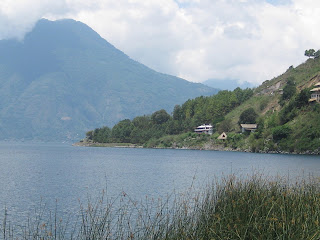
Boy in
Procesion de Jesus Nazareno del DesamparoAntigua is world famous for its celebrations during Lent and
Semana Santa (the Holy Week). I was fortunate to catch a few processions during my time there with my daughter Lorca and with Barbara Kosta since both visits fell during
Cuaresma (Lent) which constitutes the 40 days before Easter.

Workers feverishly trying to finish
whitewashing San Jose Cathedral in time for
Semana SantaBarbara and I were in Antigua on Thursday and Friday, April 2nd and 3rd. On Thursday we went to
San Jose Cathedral at the
Parque Central. Inside the church, we were awed by the special Easter arrangements and decorations. There were
andas (wooden platforms with saints on the top) ready to be carried in processions. There was also an elaborately decorated
alfombra (carpet) on the church floor which was made of painstakingly handstrewn brightly colored sawdust (with the aid of stencils). Around the
alfombra were carefully arranged fruits and vegetables as offerings, a tradition stemming from Mayan culture. The fascinating aspect of Catholic religion in Guatemala is that it has embraced Mayan religious beliefs and traditions. This is palpable in Easter celebrations as well as church architecture. Much to Barbara's and my disbelief, the
alfombra as well as the elaborate display were gone the next day. The ephemerality of the holy week artwork so carefully and beautifully executed reminded me very much of the Tibetan mandalas.
 Alfrombra
Alfrombra being created in front of the San Jose Cathedral by a tourism class

An
anda inside
the San Jose Cathedral

Part of the alfombra inside the church

Youth measuring the height of potential carriers for processions
The next day,
Viernes de Dolores, we watched and followed the
Procession de Jesus Nazareno del Desamparo at 3:00 in the afternoon throughout the city. It was an amazing unforgettable experience. Spearheading the procession was an
anda carried by boys who could not have been older than six. The boys were dressed in the traditional purple robes and they trudged with their burden through the streets. Toward the end of procession (two hours later) their parents accompanied them. I overheard one mother say to her son, "Not much longer."

Children carriers during the Friday procession

During the Friday Procession
Boy swinging a vessel of burning incense in front of the Anda
Following the young people was an
anda carried by teenaged boys. This
anda was very heavy as one could note by the size and the expression of the boys hoisting it. Apparently
andas can weigh as much as over a ton. The carriers stomped on the
alfombras illustriously displayed on the street, destroying them totally. The
anda was trailed by a band of brass and flute players as well as drummers. The music reminded one of funerals, very slow, mournful, and dignified. We thought the conductor of the band looked like a gypsy due to the type of hat he wore.

Bandleader

Teenaged boys carrying an
anda and about to trample an
alfombra
Boys carrying the
AndaDuring the procession, people gathered on the sidewalks to watch. Girls were dressed in virginal white dresses donning a postcard of a religion icon which signifies their parents contribution to a
cofradia, a religious order. Some girls joined their brothers to show their solidarity.

Child watching on the sidelines

Sister keeping brother company
After the procession, Barbara and proceeded to the
La Merced, no doubt one of the most spectacular churches in Antigua. Outside the church, there were throngs of vendors selling delicious delicacies as well as gorgeous bouquets of flowers and dried grains. Barbara was particularly struck by the aesthetically carved mangos on a stick.

La Merced

A woman selling Easter bouquets in front of
La Merced

A woman selling mangos on a stick
Apart from the special events programmed for
Semana Santa, we were struck by the spectacle of one of the surrounding volcanoes which rose above the city like an apparition. I was fortunate enough to capture its mystical appearance when we were walking on Santa Catalina, close to the arch. Antigua is no doubt one of Guatemala's jewels and being there during the
Cuaresma made it even more special.


 From left to right: Jay Raman, Maria Marta Ramos,
From left to right: Jay Raman, Maria Marta Ramos, New desks for the Center funded by Fulbright
New desks for the Center funded by Fulbright Voices for the listening part on the new
Voices for the listening part on the new Recording dialogues: I, Richard Morgan, and Josanne.
Recording dialogues: I, Richard Morgan, and Josanne.













































